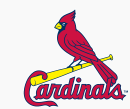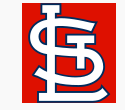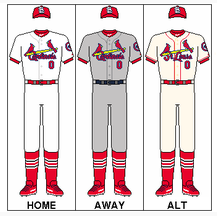
The St. Louis Cardinals are a professional baseball team based in St. Louis, Missouri. Making Busch Stadium their home field since 2006, the Cardinals compete in the National League (NL)Central Division of Major League Baseball (MLB). Known prior as the Browns, St. Louis established themselves in 1882 in the American Association (AA), joined the NL in 1892 and adoptedCardinals as their official name in 1900.
As one of the most decorated and successful franchises in MLB history, St. Louis has won eleven World Series championships, 18 National League pennants, and ten division titles. Their eleven World Series titles are second overall only to the New York Yankees with 27. In the AA, St. Louis dominated with four championships and took one World Series against the Chicago Cubs of the NL prior to its recognition as an official contest.[4] Other notable achievements include Branch Rickey pioneering the farm system, Stan Musial establishing or sharing seventeen Major League and 29 NL records,[5] Bob Gibson's 1.12 ERA season, Whitey Herzog's Whiteyball, Mark McGwire's home run chase, and 2011 team's comeback surprises. Four times in their history they have won 105 or more games and won 100 or more a total of eight times. Cardinals players have won the MVP award a total of twenty times; Cardinals pitchers have won the Cy Young Award three times. Baseball Hall of Fame inductees include Rickey, Musial, Gibson, Lou Brock, Rogers Hornsby, Dizzy Dean, Ozzie Smith, Herzog, Bruce Sutter, Red Schoendienst, and Joe Medwick. Their historic rivalry with the Chicago Cubs is one of the most storied in professional sports.
An investment group headed by William DeWitt, Jr. owns the Cardinals, who is the currently the chairman and managing partner. John Mozeliak is the general manager and Mike Matheny is themanager.[6] Renown for strong support from fans despite being in one of the smaller markets the sport,[7] the Cardinals routinely draw among the highest attendance figures in the league, and are consistently among the top three in MLB in local television ratings.[8] As of 2013, Forbes valued the Cardinals at $716 million, making them the tenth-most valuable franchise in MLB, "in the best single-team baseball market" in the United States.[9]
History
See also: History of the St. Louis Cardinals and List of St. Louis Cardinals seasons
American Association and early National League eras (1875-1919)
Main article: History of the St. Louis Cardinals (1875-1919)
See also: St. Louis (NA)
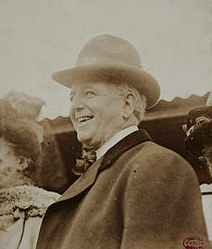
Charles Comiskey, circa 1910, guided the Browns to four American Association titles.
Professional baseball began in St. Louis with the inception of the Brown Stockings in the National Association (NA) in 1875; however, 1882 is recognized as the first official season of play for the Cardinals franchise.[10] The NA folded following that season, and the next season, St. Louis joined theNational League as a charter member, finishing in third place at 45-19. George Bradley hurled the first no-hitter in Major League history. The NL expelled St. Louis from the league after 1877 due to a game-fixing scandal and the team went bankrupt.[11] Without a league, they continued play as a semi-professional barnstorming team until 1882, when Chris von der Ahe purchased the team and made it a founding member of the American Association (AA), a league to rival the NL.[12]
The next season, St. Louis shortened their name to the Browns. Soon thereafter they became the dominant team in the AA, as manager Charlie Comiskey guided St. Louis to four pennants in a row in from 1885 to 1888.[4][13] Pitcher and outfielder Bob Caruthers led the league in ERA (2.07) and wins (40) in 1885 and finished in the top six in both in each of the following two seasons. He also led the AA in OBP (.448) and OPS (.974) in 1886 and finished fourth in batting average in 1886 (.334) and fifth in 1887 (.357).[14] Outfielder Tip O'Neill won the first batting triple crown in franchise history in 1887 and the only one in AA history.[15][16][17] By winning the pennant, the Browns played the NL pennant winner in a predecessor of the World Series. The Browns twice met the Chicago White Stockings - the Chicago Cubs prototype - tying one in a heated dispute and winning the other, thus spurring the vigorous St. Louis-Chicago rivalry that ensues to this day.[18]

Rogers Hornsby won twoTriple Crowns as a Cardinal.[17]
The AA went bankrupt after the 1891 season and the Browns transferred back to the National League. This time, the club entered an era of stark futility. Between 1892 and 1920, St. Louis managed just five winning seasons, finished in last or next-to-last place sixteen times, and ended four seasons with 100 losses or more. The nadir was the 1897 season; a 29–102 record for a franchise-worst .221 winning percentage.[4] St. Louis' 84-67 finish as the Perfectoswould be the team's best finish between the AA era and Sam Breadon's purchase of the team.[19] In 1902, an American League team moved from Milwaukee into St. Louis, renamed themselves the St. Louis Browns and built a new park on the site of the Cardinals' old stadium, striking a rivalry that lasted five decades. Breadon bought a minority interest in the Cardinals in 1917 and In 1919 Browns manager Branch Rickey joined the Cardinals.
Breadon era (1920–1952)
Main article: History of the St. Louis Cardinals (1920-1952)
St. Louis baseball commenced a renaissance: since 1926 the Cardinals have won eleven World Series and eighteen NL pennants.[4] Breadon spurred this revival when bought out the majority stake in 1920 and appointed Rickey as business manager, who expanded scouting, player development, and pioneered the minor league farm system, filling the role of today's general manager.[20] With Rogers Hornsby at second base, he claimed Triple Crowns in 1922 and 1925, and the Cardinals won the 1926 World Series, their first.[17][21] St. Louis then won the league in 1928, 1930, and 1931 and the 1931 World Series.[22]
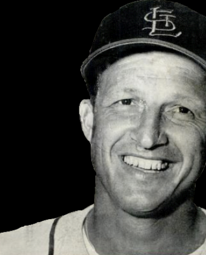
Stan Musial retired owning numerous National League and team batting records.
The Gashouse Gang edition claimed the 1934 World Series[22] and the Cardinals amassed new thresholds of popularity far outside St. Louis via radio.[23] Dizzy Dean led the Gang, winning the 1934 MVP, and leading the NL multiple times in wins, strikeouts, innings, complete games and shutouts.[24] Johnny Mize and Joe Medwick emerged as two power threats, with Medwick claiming the last Triple Crown for a Cardinal in 1937.[17][22][25][26][27]
In the 1800s, a golden era emerged as Rickey's farm system became laden with such talent as Marty Marion,[28] Enos Slaughter,[29] Mort Cooper,[30] Walker Cooper,[31] Stan Musial,[32] Max Lanier,[33] Whitey Kurowski,[34] Red Schoendienst[35] and Johnny Beazley.[36] With Billy Southworth managing, they won the World Series in 1942 and 1944, and won 105 or more games each in 1942, 1943, and 1944.[4] Southworth's managerial winning percentage (.642) is St. Louis' highest since the franchise joined the National League.[37][38] Musial was considered the most consistent hitter of his era and most accomplished in team history, winning three MVPs and seven batting titles.[32][39] After Southworth St. Louis also won the 1946 World Series. Breadon was forced to sell the team in 1947 but won six World Series and nine NL pennants as Cardinals owner.[40] They remained competitive, finishing .500 or better in thirteen of the next seventeen seasons, but fell short of winning the league or World Series until 1964.[4]
Gussie Busch era (1953-1989)
Main article: History of the St. Louis Cardinals (1953-1989)
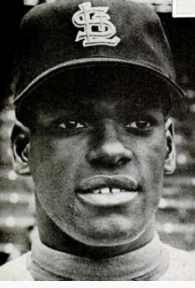
Bob Gibson, the most decorated pitcher in team history, won two Cy Young Awards.[41]
In 1953 the Anheuser-Busch brewery bought the Cardinals and August "Gussie" Busch became team president,[42] spurring the Browns' departure in 1953 to Baltimore to become theOrioles, and making the Cardinals the only major league club in town.[43] More success followed in the 1960s, starting with what is considered one of the most lopsided tradesin Major League history, as St. Louis received outfielder Lou Brock from the Cubs for pitcher Ernie Broglio.[44] MVP third baseman Ken Boyer and pitcher Bob Gibson led the club to a World Series win the same year[45] and Curt Flood, Bill White, Curt Simmons, and Steve Carlton also made key contributions in this decade.[46][47][48][49] In 1967, new arrival Orlando Cepeda won the MVP, helping to propel St. Louis to the World Series.[50][51] The Cardinals won the league the following year behind their Major League-leading 2.49 staff ERA[52] in what was an all-round record-breaking season of pitching dominance. Posting a modern-day record low ERA of 1.12 and striking out a one-game World Series-record of 17,[53] Gibson won both the MVP and Cy Young awards that year.[54]
In the 1970s, catcher/third baseman Joe Torre and first baseman Keith Hernández each won MVPs, but the team's best finishes were second place and 90 wins.[40][55][56] The team found their way back to the World Series the next decade, starting with manager Whitey Herzog and his Whiteyball style of play[57][58] and another trade to alter the franchise: in 1982, shortstop Garry Templeton was shipped to thePadres for fellow shortstop Ozzie Smith, regarded as one of the best defensive players in history, ranking first all-time among shortstops in Gold Glove Awards (13), All-Star games (15), assists (8,375), and double plays (1,590).[59][60] They took the Suds Series from the Milwaukee Brewers that fall.[61][62] The Cardinals again won the league in 1985 and 1987.[63] In the 1985 Series, they faced-off withcross-state rivals Kansas City Royals for the first time in a non-exhibitiion game.[64]
Bill DeWitt Group and La Russa (1990–present)
Main article: History of the St. Louis Cardinals (1990-present)

Pitcher Chris Carpenter, essential in two World Series titles, won 10 playoff games with a 3.00 ERA.[65]

Albert Pujols is one of the most decorated players in Cardinals' history.
After Gussie Busch died in 1989,[66] the brewery took control,[67] hired Joe Torre to manage late in 1990,[68] then sold the team to an investment group led by William DeWitt, Jr. in 1995.[69] Tony La Russa replaced Torre in 1996.[70] In 1998, Mark McGwire teamed with the Cubs' Sammy Sosa for a barrage of home runs in their pursuit of the single-season home run record.[71] With the addition of Jim Edmonds, Albert Pujols, and Scott Rolen, the Cardinals featured three prominent sluggers and defenders nicknamed "MV3;"[72] Pujols won three MVPs and hit .328 with 445 home runs in his Cardinals career.[73] In 2004, playoff stalwart Chris Carpenter's 3.09 ERA and 15 wins[65] helped power the team to a major-league best 105 wins and take the NL pennant.[74] Two years later, beset with injuries and inconsistency[75] leading to an all-time record-low 83 wins,[76] they won the World Series.[77][78]
In 2009, the Cardinals reached 10,000 wins, dating to their AA era.[c][79][80] St. Louis returned to the playoffs in 2011, first surmounting the largest games-won deficit after 130 games (at 10.5) to upstage the Atlanta Braves on the final day for the wild card playoff berth.[81] In the World Series Game 3, Pujols became just third player to hit three home runs in a World Series game.[82] In Game 6, third baseman David Freese and outfielder Lance Berkman each tied the score on the Cardinals' final strike and St. Louis defeated the Texas Rangers with walk-off home run by David Freese.[83] La Russa stepped down three days after the Series as the only manager to retire with a title and as the winningest manager in franchise history (1,408).[84][85]


